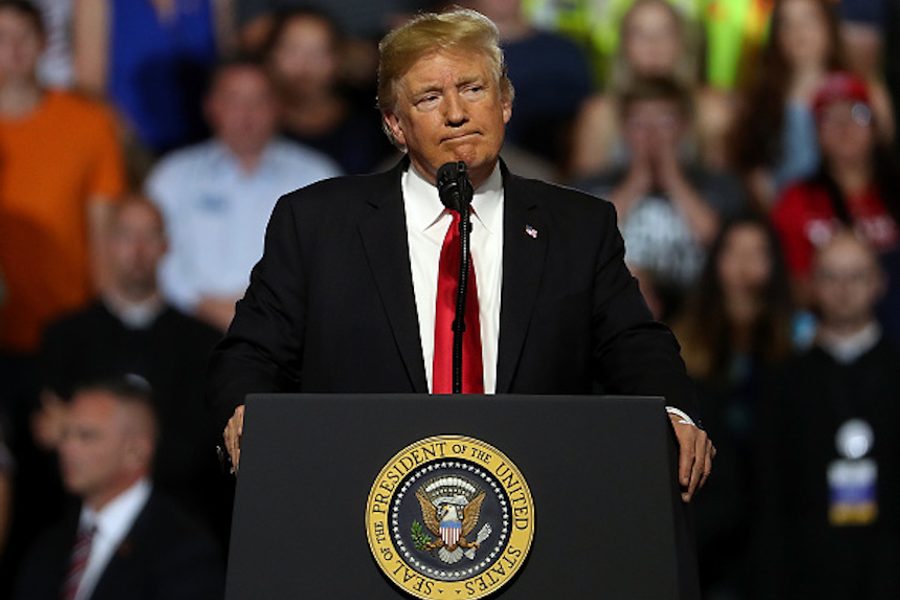Donald Trump’s Economic Plan Is a Giveaway to The Super Rich
Except for trade, Trump’s plan is big business’s plan too.
Kate Aronoff

For a man who appears so bent on breaking with tradition, Donald Trump spewed a lot of it Monday. Following in the footsteps of Republican presidential hopefuls past, Trump delivered an address outlining his “America First” economic plan to the Detroit Economic Club.
Though characteristically light on details, what Trump did say — apart from his protectionist stance on trade — fell squarely in line with the free market dogma that has taken center stage in the GOP from Ronald Reagan through both Bush administrations and the Tea Party that followed them.
“He’s basically adopted the straight Republican platform,” says Dean Baker, an economist and co-director of the progressive Center for Economic Policy and Research.
Trump emphasized that his campaign will, “offer a new future, not the same old failed policies of the past.” Yet the proposals he rattled off have been at the top of conservatives’ agenda for years and in some cases decades: Repealing the so-called death tax (estate tax) for people with more than $5.45 million to pass on, slashing taxes for the wealthy and rolling back regulations.
The few policies ostensibly about putting money into the pockets of working and middle-class families — like a child tax credit — would also end up giving households with higher incomes the biggest breaks. Among the proposals, too, was slashing the number of IRS tax brackets from seven to three, and capping taxation at 33 percent.
“This is a traditional conservative platform,” says Baker. “If you took the part about trade out and a few quips about (Hillary) Clinton, you could certainly envision this coming from Jeb Bush or Marco Rubio.”
Trump’s plan is heavy on the supply-side tax cuts and deregulation that defined Reaganomics, the logic behind which is to jump-start growth and investment rather than directly spur consumer spending. With easier access to cash, the argument goes, businesses will be more free to trickle their savings down to workers and consumers. Interest rates would also shrink as GDP swells.
“The impact of these tax cuts on interest rates is basically zero,” Baker says, noting that only a fraction of the small business owners Trump referenced in his speech are calling for rate reductions. Inflation has been persistently low, too, undershooting targets set by the Federal Reserve Bank.
“The argument for a supply-side tax cut has is weak, but it’s particularly weak now,” Baker says.
Despite 14 disruptions from the crowd, the speech was one of Trump’s best attempts to stay on script, veering only slightly from his prepared remarks. He mostly restrained himself when interrupted, in what might be a sign of Trump’s pivot to appealing more to his party’s center.
Even Trump’s more brazen-sounding proposals, like a “temporary moratorium” on new regulations and a promise to cancel all “illegal and overreaching” executive orders, are — by now — commonplace GOP rallying cries. Twenty-seven states are suing the Environmental Protection Agency over the Clean Power Plan, which was enacted under executive order. Some states have also filed suit to stop another executive action program, known as Deferred Action for Childhood Arrivals (DACA). Each order now sits stymied in the federal system thanks to Supreme Court rulings.
Aside from being GOP standard fare, the lion’s share of Trump’s plan has also been a priority for big business. A report from the Center for American Progress released in June found that 43 of the country’s top 100 power producers have either directly or indirectly supported the states’ suits against the Clean Power Plan. The Koch Brothers’ Americans for Prosperity has a long history of fighting the plan and other energy regulations, as well.
That Trump’s plan is so in line with lobbyist and establishment GOP demands is even more confounding based on the way his campaign and the plan itself are being framed. Minutes after saying that Clinton “is bought, controlled and paid for by her donors and special interests,” Trump cited a study by the fossil fuel-industry backed Heritage Foundation on the job loss that might be wrought by “Obama-Clinton energy restrictions.” His plans to tear up the Paris Agreement and regulations on oil and gas producers are straight out of the industry’s own playbook.
Not only is Trump’s plan is a boon to corporations, but his advisory team is stacked with bankers and billionaires who also happen to be some of his biggest donors. Politico reports that his all-male team of advisers features five of the GOP’s top patrons, having gifted a collective $2 million to Trump’s run so far.
Only one adviser holds a doctorate in economics, and among the group are a Goldman Sachs alum (Steve Mnuchin) and the former chief economist for Bear Sterns (David Malpass). Notably absent, Baker said, are prominent conservative economists like N. Gregory Mankiw, who served as a key adviser to both George W. Bush and Mitt Romney but distanced himself from Trump.
What Trump’s speech may have clarified is that his platform is a louder, brasher version of what the GOP and its corporate backers have been building since the 1970s. His stance on free trade is an outlier against a program that’s more or less in line with Republican interests, even if the vehicle delivering it — Trump himself — is (for now) one the party’s establishment if chafing up against.
“We’ve tried this experiment and it didn’t work,” Baker says about Trump’s policies.
Free trade hasn’t been the only thing ailing workers these last 30 years, and Trump’s economic plan doubles down on the failed austerity policies that have left ordinary Americans scraping by. From Wall Street to the fossil fuel industry, Trump is in bed with big business. His plans for the economy offer exactly what it wants: More of the same.
Kate Aronoff is a staff writer at The New Republic and author of Overheated: How Capitalism Broke the Planet — And How We Fight Back. She is co-author of A Planet To Win: Why We Need a Green New Deal and co-editor of We Own the Future: Democratic Socialism—American Style. Follow her on Twitter @katearonoff.








